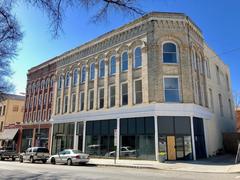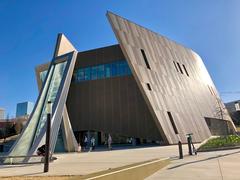Hotel Aragon Visiting Hours, Tickets, and Guide to Atlanta Historical Sites
Date: 03/07/2025
Introduction
Nestled in the heart of Atlanta’s historic Peachtree Street corridor, the Hotel Aragon once stood as a beacon of luxury, societal prestige, and architectural grandeur during the city’s transformative Gilded Age. Constructed in the 1890s, this multi-story landmark embodied Atlanta’s rapid ascent from a post-Civil War railroad hub into a thriving Southern metropolis, serving as a premier destination for business travelers, dignitaries, and social elites. Although demolished in the mid-20th century during urban renewal efforts, the Aragon’s legacy remains a touchstone in Atlanta’s architectural history and collective memory.
Today, visitors can connect with the spirit of the Hotel Aragon by exploring its former site in the bustling Peachtree Center, nearby historic hotels, and museums that celebrate Atlanta’s rich hospitality heritage. This comprehensive guide delves into the Aragon’s storied past, its role in shaping Atlanta’s urban and social fabric, and provides practical information for exploring the city’s historic landmarks. For archival materials and curated walking tours, resources such as the Digital Library of Georgia and the Atlanta History Center are invaluable. Visitors can also utilize modern tools like the Audiala app for interactive tours and updated maps of Atlanta’s historic districts.
By highlighting accessibility, nearby attractions, and tips for an enriching visit, this guide ensures that the legacy of the Hotel Aragon—and Atlanta’s dynamic blend of history and modernity—remains accessible to all (Wikipedia: Hotels in Atlanta, Discover Atlanta).
Table of Contents
- Introduction
- Early History and Construction
- The Aragon’s Role in Atlanta Society
- The Aragon and Atlanta’s Hotel Boom
- Decline and Legacy
- Visiting Atlanta’s Historic Hotel Sites
- Hotel Aragon Location and Visiting Information
- Frequently Asked Questions (FAQ)
- Conclusion
- Key Facts and Figures
- Further Reading and Resources
Early History and Construction
Atlanta’s Growth and the Rise of Grand Hotels
The late 19th century marked a period of rapid transformation for Atlanta, as the city evolved from a post-war railroad hub into a major urban center. The burgeoning population and economic expansion created a demand for high-end accommodations. The Hotel Aragon, constructed in the 1890s, epitomized Atlanta’s aspirations for grandeur and modernity, offering luxury to travelers and the city’s elite (Wikipedia: Hotels in Atlanta).
Construction and Architectural Features
Built on prominent Peachtree Street, the Aragon was an imposing multi-story structure, notable for its ornate architectural detailing and grand scale. Its striking façade quickly became an architectural landmark, reflecting the optimism and economic vitality of post-Reconstruction Atlanta (History Atlanta).
The Aragon’s Role in Atlanta Society
Social and Cultural Significance
Beyond accommodations, the Aragon served as a central gathering place for Atlanta’s elite, hosting political events, lavish social gatherings, and cultural celebrations. Its proximity to key sites like the Governor’s Mansion and Leyden House underscored its influence in the city’s civic and social life (History Atlanta).
Notable Guests and Events
The hotel’s ballrooms and rooftop offered panoramic views and regularly featured in period photographs documenting major city events. The Aragon played host to dignitaries, business magnates, and celebrities, solidifying its reputation as a hub of Atlanta’s social and political activity.
The Aragon and Atlanta’s Hotel Boom
Competition and the Hotel District
As Atlanta’s “Hotel District” along Peachtree Street flourished in the late 19th and early 20th centuries, the Aragon stood out among luxury peers like the Kimball House, Markham House, Majestic, and Piedmont hotels. It helped anchor the city’s hospitality industry, serving travelers arriving by rail and, later, by automobile (Wikipedia: Hotels in Atlanta).
Architectural and Urban Impact
The Aragon contributed to transforming Peachtree Street into Atlanta’s premier commercial boulevard, influencing the design of subsequent hotels and encouraging the rise of theaters, restaurants, and retail establishments in the vicinity.
Decline and Legacy
Changing Tastes and Urban Development
By the mid-20th century, shifting travel trends and the construction of modern hotels like the Hyatt Regency and Westin Peachtree Plaza eclipsed the Aragon. Unable to keep pace with new high-rise competitors, the Aragon’s prominence waned (Wikipedia: Hotels in Atlanta).
Demolition and Historical Memory
Demolished during urban renewal in the late 1920s, the Aragon survives in historic photos, archival documents, and local memory. Its story provides critical insight into Atlanta’s architectural and social evolution (History Atlanta).
Visiting Atlanta’s Historic Hotel Sites
Exploring Related Historic Sites
While the Aragon itself no longer stands, visitors can explore the vibrant Peachtree Center area, where its legacy continues. Notable historic hotels nearby include the Glenn Hotel and the American Hotel. The Digital Library of Georgia offers rich visual archives and documents for further exploration.
Museums and Guided Tours
The Atlanta History Center and other institutions feature exhibits on Atlanta’s hospitality history. Guided walking tours often include the former Aragon site and related historic landmarks, offering deep dives into the city’s hotel heritage.
Visitor Information and Travel Tips
Although the Hotel Aragon is gone, its site remains publicly accessible. Downtown’s Peachtree Street offers excellent walkability, public transit access, and proximity to major museums and attractions.
Hotel Aragon Location and Visiting Information
Location and Accessibility
The Hotel Aragon once stood at 169 Peachtree Street NE, at the southeast corner of Ellis Street in downtown Atlanta. Today, this location is part of the dynamic Peachtree Center area, easily reached via MARTA and major downtown thoroughfares (Discover Atlanta). The neighborhood remains pedestrian-friendly, with wide sidewalks and convenient access to public transport.
Visiting Hours and Ticket Information
As the actual hotel no longer exists, visitors can explore the former site at any time during daylight hours. There is no admission fee. Nearby museums have regular hours (e.g., Atlanta History Center: Tues–Sun, 10 a.m.–5 p.m.), and walking tours featuring the site may require advance tickets, typically ranging from $15 to $25 (Discover Atlanta: Walk Through History).
What to Expect at the Site Today
Modern developments now occupy the former Aragon site, including the MARTA Peachtree Center station and the Georgia Pacific Center. The area is bustling, with a mix of historic and contemporary architecture, vibrant restaurants, hotels, and cultural venues. Historical markers and interpretive signage may be present, depending on current heritage initiatives.
Visitor Experience
The downtown atmosphere is lively, especially during business hours and major events. The area is considered safe for visitors, particularly in well-trafficked locations, with hotels and security presence adding to overall comfort (Travellers Worldwide: Is Atlanta Safe to Visit in 2025?). Accessibility for wheelchair users and those with mobility challenges is generally good.
Practical Tips for Visitors
- Best Times to Visit: Spring (March–May) and fall (late September–November) offer mild weather and plenty of cultural events. Summers can be hot, while winter brings fewer crowds and lower rates (Travellers Worldwide: Best Time to Visit Atlanta).
- Dining Options: The area features diverse eateries, from the Terrace Bistro and Lounge to classic Southern kitchens along Peachtree Street (Trip101: Historic Hotels Atlanta).
- Nearby Accommodation: Stay at historic hotels like the Candler, Georgian Terrace, or Ellis Hotel for a blend of history and comfort.
- Events: Check the Atlanta events calendar for concerts, festivals, and annual celebrations such as the FIFA Club World Cup 2025.
- Guided Tours: Book a historical walking tour to gain deeper insights into Atlanta’s architectural evolution (Discover Atlanta: Walk Through History).
Cultural Insights
The Hotel Aragon’s story is emblematic of Atlanta’s emergence as a center for commerce, hospitality, and culture during the Gilded Age. Its legacy is preserved through museum exhibits, digital archives, and local historical societies. For those seeking a deeper connection, visit:
- Atlanta History Center: Exhibits on Atlanta’s growth and hospitality industry.
- National Center for Civil and Human Rights: Contextualizes Atlanta’s broader historical significance (Discover Atlanta: National Center for Civil and Human Rights Expansion).
Frequently Asked Questions (FAQ)
Q: Can I visit the Hotel Aragon today?
A: The original building was demolished in the late 1920s. However, its former site at Peachtree and Ellis Streets is publicly accessible.
Q: Are there guided tours including the Aragon site?
A: Yes, several walking tours highlight the former Hotel Aragon as part of Atlanta’s historic hotel district.
Q: What are the best times to visit downtown Atlanta?
A: Spring and fall offer the most pleasant weather and a vibrant events calendar.
Q: Is the area safe for tourists?
A: Yes, downtown Atlanta is generally safe during the day and in busy areas. Exercise standard urban precautions.
Q: Where can I find historic images or archives about the Hotel Aragon?
A: The Digital Library of Georgia offers a robust collection of photographs and documents.
Key Facts and Figures
- Era of Operation: Late 19th century to mid-20th century
- Original Location: 169 Peachtree Street NE, Atlanta, Georgia
- Architectural Style: Grand, multi-story design typical of Gilded Age hotels
- Role: Social and cultural hub for Atlanta’s elite
- Demolition: Late 1920s during urban renewal
- Legacy: Symbol of Atlanta’s Gilded Age and ongoing urban evolution
Visual Resources
Alt text: Historic black and white photograph of Hotel Aragon on Peachtree Street, Atlanta, showcasing its ornate façade and multi-story design. Alt text: Map highlighting the historic Hotel District along Peachtree Street in Atlanta, including the former location of the Hotel Aragon.
For digital walking tours and additional visuals, visit the Audiala app or Discover Atlanta website.
Summary and Recommendations
The Hotel Aragon stands as a cherished chapter in Atlanta’s development—a grand hotel that embodied the city’s ambitions, social dynamism, and architectural innovation at the turn of the 20th century. Though the building is gone, its legacy endures in the urban landscape of Peachtree Center, in archival collections, and through the storytelling of Atlanta’s museums and historians. Visiting the site today offers a tangible connection to Atlanta’s past and a unique vantage point for appreciating the city’s ongoing transformation.
For a memorable visit, plan ahead with walking tours and museum stops, enjoy local cuisine and nearby attractions, and use digital resources like the Digital Library of Georgia, Atlanta History Center, and Discover Atlanta. Enhance your experience with the Audiala app, which provides interactive guides and updates on Atlanta’s cultural events (Wikipedia: Hotels in Atlanta).
References and Further Reading
- Wikipedia: Hotels in Atlanta
- History Atlanta: The Old Leyden House Columns
- Digital Library of Georgia: Aragon Hotel
- Discover Atlanta: Walk Through History
- Travellers Worldwide: Is Atlanta Safe to Visit in 2025?
- Trip101: Historic Hotels Atlanta
- Discover Atlanta: National Center for Civil and Human Rights Expansion
- Discover Atlanta: Main Events Calendar
For more travel tips and to enhance your experience, download the Audiala app and follow us on social media. Explore related articles on our site to discover more about Atlanta’s rich history and vibrant culture.

